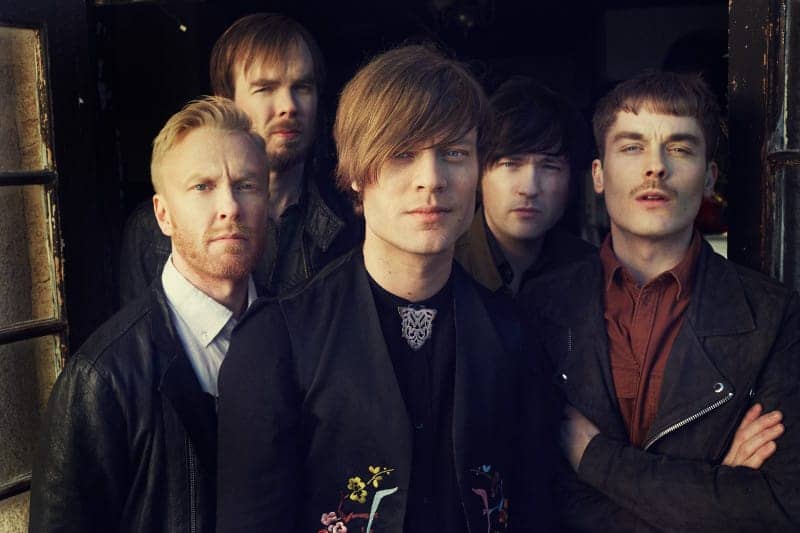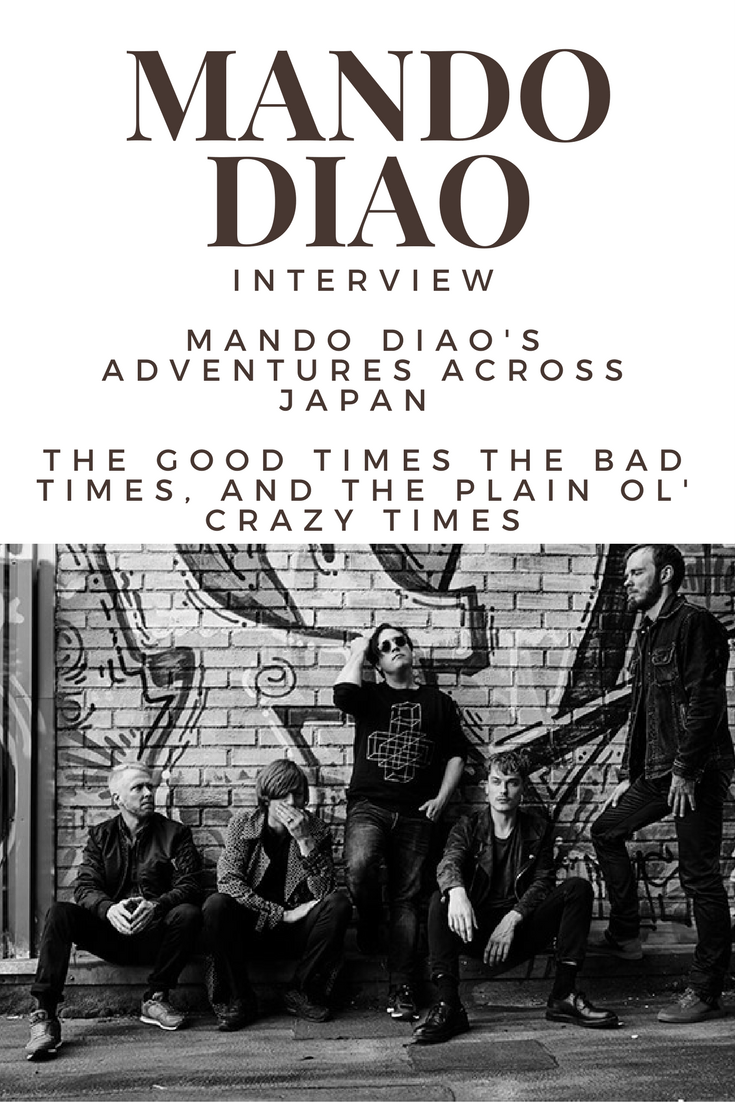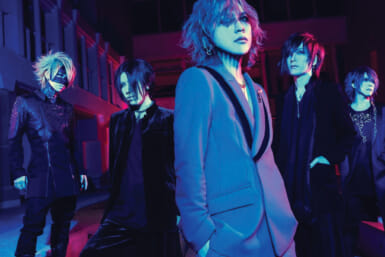Mando Diao are household names across Europe, with particularly strong fan bases in their homeland of Sweden, as well as Germany and Austria — and, a seeming outlier, Japan. Their rock’n’roll and old school rhythm and blues style has won them a very passionate following here – and the affection is mutual. The band has spent a lot of time here over their career. In fact, they’re so comfortable in Japan that they filmed the video “Sweet Wet Dreams,” a song from their 2014 album Aelita at major Kabukicho tourist draw, the Robot Restaurant.
Mando Diao released their latest album Good Times in May 2017, which sees the band return to a stronger sound using a mix of synth sounds and dance music and injecting that into their old school rock rhythms.
Weekender talks with Mando Diao members Björn Dixgård (vocals, guitar), Carl-Johan Fogelklou (bass), and Jens Silverstedt (guitar) about the band’s return to Japan after an eight-year hiatus, their favorite Ghibli movies, their “good times” in Japan and some really crazy bars.
It’s been eight years since your last show in Japan – what are your expectations ahead of this hiatus?
Dixgård: We don’t really know what to expect since it’s been so long since we were there last. But I guess it’s kind of a restart in a way.
Fogelklou: Although at the same time, it’s almost like a homecoming. I mean for a while we were coming to Japan at least once a year. So we feel very comfortable there. It’ll be nice to go back to a place we know pretty well.
Why do you think your music resonates so well with a Japanese audience?
Dixgård: I don’t think you can do analyses like that. If I knew the answer to that, we’d be the biggest band in the world! [Laughs] I wish I knew. It’s been like that our whole career — some albums have gone well in certain countries while others didn’t work out at all in other places. It’s completely impossible to guess. The only thing we can do is follow our hearts.
Fogelklou: I guess that’s how it works when you make the music yourself. You can’t get a perspective on it. We’ll have to ask others to create that perspective.
Dixgård: Just tell us when we suck, basically. [Laughs]
What have been some of your good times in Japan?
Dixgård: When we broke into the Japanese market in 2003, we were still super nerds about The Beatles. We aren’t as much anymore, I can tell you. So back then we went to a place called The Cavern Club [a popular go-to spot in Roppongi for Beatles enthusiasts and musicians that closed in the spring of 2011] and basically, it was a replica of Liverpool’s Cavern Club, where The Beatles famously played. There was a great band there that we saw at least five or six times every time we were in Tokyo.
Dixgård: We’ve enjoyed arcades and discos, especially in Roppongi.
Fogelklou: Lexington [the Lexington Queen, which is now known as the New Lex Tokyo], I think was one of them. That one was good. One thing I love about being in Japan is that … I’m not so tall – about 167 centimeters – so a lot of things are the perfect size for me. Also, when we first came here, it was the first time in my life I could see the top of people’s heads. [Laughs]
What about the bad times?
Dixgård: “Well, the first time we went to Japan it was a bit of an existential crisis for me. I had only been in Borlänge, my hometown, which has a population of like 50,000 people. I felt like such a country bumpkin coming to a huge city like Tokyo. But by the second time I knew my way around, so it was much better. And since then I’ve loved Japan. That first time was pretty shaky though.
Fogelklou: It was a little bit different for me since I’m from Sigtuna [a town close to Stockholm] and everyone else in the band was from Borlänge, so I had experience with and loved the food culture in Japan from the outset. The others complained, “I never feel full from this,” or asked, “where’s the meat?” [Laughs]
Dixgård: Yeah it was a rough adjustment at first. I had to always ask for a fork and knife everywhere we went. But now I can eat with chopsticks. I prefer eating with them, actually. Oh, and (speaking of bad times) there was that rollercoaster over by the Tokyo Dome complex. That was no picnic. I thought I was going to die.
And how about the crazy times?
Fogelklou: One time we went to a cowboy club. I don’t remember where it was, but it wasn’t in Tokyo. Anyway, when we rocked up there, there were 12 or 13 people dancing line dance wearing giant cowboy hats. That was really unexpected.
Dixgård: Another time we went all the way up a skyscraper because we’d heard about a random bar or club or something.
Fogelklou: I think it was a whisky – no, a vinyl bar!
Dixgård: Yeah, a vinyl bar. So we went there. And then the bartenders had some kind of show they called “fish fights.” Basically, they wore fish heads and danced around in thongs for us. They danced some really erotic dances with themselves and us. That was great.
Dixgård: Then of course there’s Kagaya [an izakaya that has been granted Internet fame for its crazy ordering system and the owner’s surprising sense of humor]. You guys (Silverstedt and Fogelklou) haven’t been there, but it’s totally crazy. I can totally recommend it. We asked the front desk at the hotel we were staying in to tell us what the craziest place in Tokyo was, and they told us about that bar. There’s this one guy who’s in charge of everything and even does a show. His humor is insane. You’re not allowed to see what he’s going to serve. You just choose a country and he’ll serve you food according to that theme, and even put on a show related to that.
Are there any differences between Swedish and Japanese fans that you’ve noticed?
Fogelklou: The audiences in Japan are outstanding. They’re so wild and crazy – in a good way. They jump around and dance to the music. They’re like proper, hardcore fans. I feel like Japanese fans are committed on a whole different level. It’s admirable how dedicated they are.
Dixgård: They’re great at shows too. Swedish fans are dedicated as well, but they’re a little bit more reserved. I feel like there’s an appreciation there that isn’t as strong in Sweden.
Fogelklou: It’s a different fan culture, I think.
Dixgård: Yeah, in Sweden, they’ll go to the show but they don’t need your autograph. It’s so different in Japan, where it’s part of the whole band experience, which is really fun.
Is there anything you’d like to do on this next visit?
Fogelklou: Yeah, we have to make time (to get out more). I’ve never been to an oxygen bar. And we have to do Kyoto. Also, I promised my daughter I’d buy some stuff for her. She loves Japan. So I said I’d get her the same outfit that Chihiro wears in Spirited Away. I mean, it’s really simple – it’s just a white t-shirt, red shorts and some sneakers, but she really wants it. So I’ll have to look around for that.”
Dixgård: Ghibli makes such great movies. We’re all big fans of their films.
Do you have any favorites?
Fogelklou Ponyo, actually. It’s so good!
Dixgård: Yeah, it’s great. Spirited Away is awesome, too. Those two, I guess. Although Howl’s Moving Castle is pretty great as well.
How do you find the food here?
Dixgård: I tried pufferfish (fugu), so that was kind of scary. I know it’s prepared correctly, but there’s always the risk.
Fogelklou: The first time we came here we didn’t get sushi even once. We were told, “You have sushi in Europe, so we’re going to give you real Japanese food.” And when we were served, it was just a few beans. So we ate the beans and wondered, “Oh no, is this going to be it!?” We had never experienced being served so many small dishes that came one after the other, so we kept thinking “Oh crap, there’s so little food!” but then it just kept on coming!
And a final message to our readers ahead of your Japan gigs?
Dixgård: You can’t miss Sweden’s best ever band! You just can’t. You’ll regret it for the rest of your lives.
Silverstedt: I think that if you want to see a real damned rock band and experience a live stage performance then you should come see us.
Mando Diao will be playing in Tokyo January 9 & 10 at Shibuya Quattro. Click here for more details.










